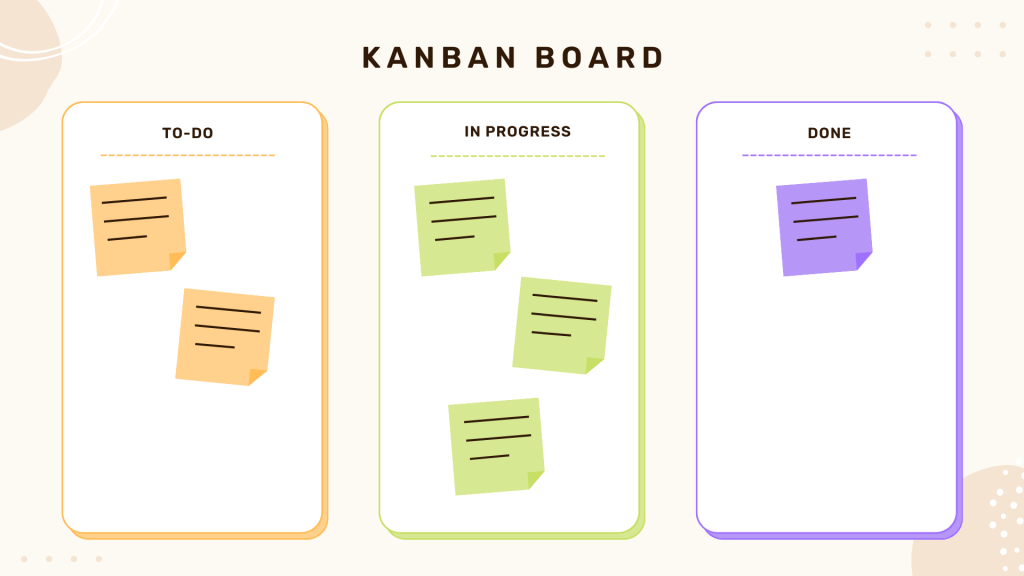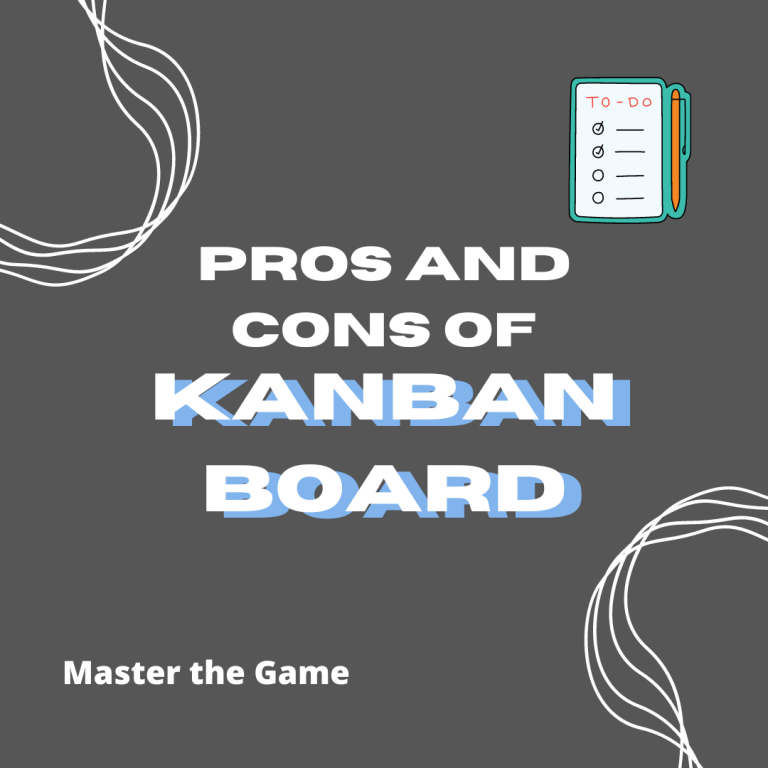Have you ever found yourself drowning in an avalanche of tasks? Or perhaps you’ve been part of a team that struggled to coordinate and track their workflow. If that sounds all too familiar, you’ve likely sought out a life-raft in the form of various project management methodologies. One such life-raft is the Kanban Board.
But is this life-raft your path to project management nirvana, or will it leave you stranded in the open sea of disorganization?
Let’s embark on a journey of exploration as we dive deep into the ‘Pros and Cons of Kanban Board’. This nifty tool, rooted in Japanese manufacturing, has found its way into various industries and teams across the globe. But is it the right fit for you?
So, whether you’re a project management veteran or a novice setting sail in these waters for the first time, this comprehensive guide to the ‘Pros and Cons of Kanban Board’ is your trusty compass. Ready to navigate these waters? Let’s set sail!
What is the Kanban board?

A Kanban Board is a visual tool that helps in the management of tasks or projects by visualizing workflow. Originating from the Japanese manufacturing sector, Kanban has since been adapted across various industries as a popular project management methodology.
The board is typically divided into different stages of a task, often labelled as ‘To Do’, ‘In Progress’, and ‘Done’. Tasks or projects are represented as cards that move from one column to the next as they progress. This simple visual representation allows teams to have a clear overview of the status of tasks at a glance, manage work-in-progress effectively, and identify any bottlenecks in the process.
In essence, a Kanban Board serves as a real-time information repository, enhancing team communication and productivity.
Advantages of the Kanban Board
#1 Visualization of Work
Visualizing work with a Kanban Board is like trading a tangled ball of yarn for a neatly organized knitting pattern. Each individual task gets its own card, transforming a lengthy to-do list into a clear, visual format. This dramatic shift turns each task into a tangible block that can be moved across your board as it progresses.
Imagine having all your tasks, their current status, and the flow of work spread out before you in an easy-to-read layout. With each task’s crucial information such as deadlines, assigned team members, and priority level all available on the board, it’s akin to having a mini dossier for each task at your fingertips.
This bird’s-eye view of your project enables you to quickly gauge the overall progress and efficiently decide the next steps. No longer do you have to flip through countless documents or tabs. Instead, you get a streamlined overview that catalyzes decision-making and fosters a sense of control.
#2 Real-time Updates
Step into the world of Kanban Boards and say goodbye to the delay between action and its reflection. One of the most compelling advantages of using a Kanban Board is the real-time updates it offers. As tasks shift from one phase to another, your Kanban Board moves with them, mirroring each step in the journey instantly.
Imagine a sports commentary where you’re updated about every move the moment it happens. This live feed of progress eliminates the need for constant check-ins or status meetings. All changes are reflected instantly on the board, providing a living, breathing representation of your project’s state.
The benefit of this dynamic feature is two-fold. Firstly, it keeps all team members on the same page, fostering an environment of transparency and collaboration. Secondly, it allows managers to swiftly identify bottlenecks and resolve issues, thereby preventing delays and enhancing efficiency.
#3 Limitation of Work-In-Progress (WIP)
In the grand orchestra of project management, the Kanban Board plays the role of an effective conductor, ensuring each musician (read task) gets the right amount of attention. It achieves this through a key feature: the limitation of Work-In-Progress or WIP.
By setting a cap on the number of tasks in progress, the Kanban Board encourages your team to focus on completion rather than initiation. Imagine running a relay race where the baton must be passed before the next runner can start. This approach prevents tasks from piling up in the ‘doing’ stage and streamlines the workflow towards ‘done’.
This focused approach pays off in the form of improved productivity and quality. It’s like aiming a spotlight on a stage; with the light concentrated in one area, the performer (task) in focus can shine. It keeps the team aligned with the project goals and reduces the risk of context-switching and multitasking, leading to efficient work practices and high-quality results.
#4 Improved Efficiency
If you’ve ever been stuck in a traffic jam, you know how important smooth flow is. The Kanban Board is like your personal traffic officer, guiding your project tasks to their destination with minimal delay. How does it do this? By shining a light on your workflow and uncovering hidden efficiency killers.
With a Kanban Board, the journey of each task is visually traced from start to finish. This map of progress not only helps manage work but also exposes any bottlenecks or slowdowns. It’s like having a GPS that shows real-time traffic; you can spot the snarl-ups and reroute before you get stuck.
Once these roadblocks are identified, they can be scrutinized and resolved, leading to continuous improvement in the workflow. Over time, this results in a more efficient, streamlined work process where tasks flow smoothly from ‘to-do’ to ‘done’. It’s a virtuous cycle of improvement, where the aim is to reduce waste, maximize value, and, ultimately, accelerate project delivery.
#5 Flexibility
The beauty of the Kanban Board is not just in its visual appeal or its real-time progress tracking; it’s also in its flexibility. This tool is like the chameleon of project management, able to adapt to a variety of environments and needs.
Whether you’re a software development team dealing with an array of bugs and features, a marketing team juggling multiple campaigns, or a customer support team managing a slew of customer queries, the Kanban Board molds itself to fit your unique requirements. It’s like having a wardrobe that adjusts to every fashion season, providing what you need when you need it.
You can customize the columns, categories, tags, and even the color codes on your board. This customization allows you to set up workflows that mirror your specific processes and stages. The result? A management tool that is tailor-made for your team, improving not just the understanding of tasks but also their execution.
#6 Reduced waste
A major advantage of a Kanban Board is its dedication to minimizing waste. Just like a seasoned chef uses every part of an ingredient, Kanban encourages the optimal use of resources, reducing waste and maximizing value.
How does this happen? It starts with the visualization of the workflow. By laying out each task’s journey, Kanban makes it easy to spot any unnecessary steps or bottlenecks. It’s like having a magnifying glass over your process, revealing all the tiny inefficiencies that were previously invisible.
Next, the limitation of Work-In-Progress (WIP) ensures that the team is not overwhelmed with too many tasks at once. This focus helps prevent resources from being spread too thin and reduces the time wasted on task-switching.
Finally, by embracing continuous improvement, the Kanban methodology helps teams iteratively refine their processes, systematically trimming the fat and keeping only what adds value. The result is a lean, efficient workflow that saves time, money, and effort.
Disadvantages of the Kanban Board
#1 Over-Simplification
While the simplicity of a Kanban Board is its major selling point, there are instances where it could become a hindrance. Particularly in complex projects with many interdependent tasks, the Kanban Board’s simplicity may over-simplify and mask the intricacies.
Imagine trying to navigate a bustling city with a basic map that only shows major roads. While the map is simple and easy to understand, it fails to capture the intricate network of alleys and smaller streets. Similarly, a Kanban Board might fail to capture the nuanced dependencies and relationships between tasks in a complex project.
This over-simplification could potentially lead to miscommunication or oversight. Important tasks might be misjudged or lost in translation, potentially impacting the project’s progress and success.
#2 Over-complication
On the flip side of over-simplification is the risk of over-complication. With the Kanban Board’s highly customizable nature, there’s a chance of getting carried away with the options. Too many columns, tags, and color codes can transform a clear, visual tool into a confusing, cluttered maze.
Imagine a painter who has a wide array of colors at their disposal. While this can lead to beautiful, intricate artwork, it can also result in a confusing jumble if not used judiciously. Similarly, excessive customization of the Kanban Board can defeat its purpose of visual clarity and simplicity.
The challenge lies in finding the right balance in customization. Over-complication can lead to confusion, increased learning curve for the team, and potentially slow down the project’s progress. It’s important to remember that while customization is a strength, it should be used in moderation to keep the board simple and intuitive.
#3 Lack of Time Management
One area where the Kanban Board falls short is time management. Unlike some project management tools that allow for detailed scheduling and deadline tracking, the Kanban Board’s focus is predominantly on task progression.
Imagine trying to use a sun-dial to keep track of time down to the second. While it gives a broad picture, the finer details are lost. Similarly, while a Kanban Board is excellent at providing a visual workflow, it doesn’t specifically accommodate due dates or timelines within its structure.
This absence of time tracking can potentially lead to lax time management. Without a clear deadline in sight, tasks could linger in the ‘doing’ stage longer than necessary. For projects with strict timelines and schedules, this could become a considerable disadvantage.
#4 Dependent Tasks
Another area where a Kanban Board might not be the ideal tool is in managing dependent tasks. In projects where certain tasks rely on the completion of others to commence, the linear structure of a Kanban Board might not capture these dependencies effectively.
Imagine trying to assemble a puzzle without the picture on the box. While each piece (or task) is crucial, the overall image (or project) only comes together when they fit in the right places. Similarly, a Kanban Board might fail to adequately illustrate the interconnectivity and sequence of tasks, potentially leading to confusion or delay.
Tasks that need to be performed in a specific order or require the input from another task may not be well-represented on the Kanban Board. This could lead to misunderstanding the project’s scope, underestimating the time required, or overlooking key tasks.
#5 Requires Self-Discipline
The last potential drawback we’ll examine is the reliance on self-discipline in the Kanban methodology. While the Kanban Board provides a clear, visual guide, it’s largely up to the individual or team to pull tasks and move them across the board.
Think of a gym membership card. While it gives you access to all the equipment, it’s ultimately up to you to get there and put in the work. Similarly, the Kanban Board requires a high level of discipline and proactiveness from its users.
If team members neglect to update the board in real-time, tasks could be inaccurately represented. Moreover, with Kanban’s pull-based system, there is a need for team members to take initiative and manage their tasks independently.
While this fosters a sense of responsibility and autonomy, it could be a disadvantage in teams where self-management is a challenge. A lack of discipline could lead to outdated boards, misrepresentation of task progress, and ultimately, affect the project’s success.
#6 Difficulty in Measuring Progress
While the Kanban Board excels at showing the movement of tasks from one stage to another, it’s not inherently designed to measure the actual progress of the project. The visual nature of the tool provides a good sense of task status but might not offer a granular view of how much work has been completed.
Imagine a traveler walking on a winding road. While they can see the path they’ve covered, it’s hard to estimate the distance traveled or the remaining journey. Similarly, a Kanban Board shows the status of tasks, but it might not provide a clear indication of how close the project is to completion.
The task-based focus of Kanban could lead to a situation where many tasks are in progress, but few are actually completed. This could create a false perception of progress. Teams may struggle to accurately measure the percentage of work completed or estimate the time required to finish the project.




